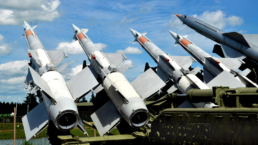Trump’s Washington breathes new life into the military-industrial complex.
By William D. Hartung, Tom Dispatch
When, in his 1961 farewell address, President Dwight D. Eisenhower warned of the dangers of the unwarranted influence wielded by a partnership between the military and a growing cohort of U.S. weapons contractors and came up with the ominous term “military-industrial complex,” he could never have imagined quite how large and powerful that complex would become. In fact, in recent years, one firm — Lockheed Martin — has normally gotten more Pentagon funding than the entire U.S. State Department. And mind you, that was before the Trump administration moved to sharply slash spending on diplomacy and jack up the Pentagon budget to an astonishing $1 trillion per year.
In a new study issued by the Quincy Institute for Responsible Statecraft and the Costs of War Project at Brown University, Stephen Semler and I lay out just how powerful those arms makers and their allies have become, as Pentagon budgets simply never stop rising. And consider this: in the five years from 2020 to 2024, 54% of the Pentagon’s $4.4 trillion in discretionary spending went to private firms and $791 billion went to just five companies: Lockheed Martin ($313 billion), RTX (formerly Raytheon, $145 billion), Boeing ($115 billion), General Dynamics ($116 billion), and Northrop Grumman ($81 billion). And mind you, that was before Donald Trump’s Big Beautiful Budget bill landed on planet Earth, drastically slashing spending on diplomacy and domestic programs to make room for major tax cuts and near-record Pentagon outlays.
In short, the “garrison state” Eisenhower warned of has arrived, with negative consequences for nearly everyone but the executives and shareholders of those giant weapons conglomerates and their competitors in the emerging military tech sector who are now hot on their trail. High-tech militarists like Peter Thiel of Palantir, Elon Musk of SpaceX, and Palmer Luckey of Anduril have promised a new, more affordable, more nimble, and supposedly more effective version of the military-industrial complex, as set out in Anduril’s “Rebooting the Arsenal of Democracy,” an ode to the supposed value of those emerging tech firms.

Curiously enough, that Anduril essay is actually a remarkably apt critique of the Big Five contractors and their allies in Congress and the Pentagon, pointing out their unswerving penchant for cost overruns, delays in scheduling, and pork-barrel politics to preserve weapons systems that all too often no longer serve any useful military purpose. That document goes on to say that, while the Lockheed Martins of the world served a useful function in the ancient days of the Cold War with the Soviet Union, today they are incapable of building the next-generation of weaponry. The reason: their archaic business model and their inability to master the software at the heart of a coming new generation of semi-autonomous, pilotless weapons driven by artificial intelligence (AI) and advanced computing. For their part, the new titans of tech boldly claim that they can provide exactly such a futuristic generation of weaponry far more effectively and at far less cost, and that their weapons systems will preserve or even extend American global military dominance into the distant future by outpacing China in the development of next generation technologies.
Could there indeed be a new, improved military-industrial complex just waiting in the wings, one aligned with this country’s actual defense needs that doesn’t gouge taxpayers in the process?
Don’t count on it, not at least if it’s premised on the development of “miracle weapons” that will cost so much less and do so much more than current systems. Such a notion, it seems, arises in every generation, only to routinely fall flat. From the “electronic battlefield” that was supposed to pinpoint and destroy Viet Cong forces in the jungles of Southeast Asia in the Vietnam War years to Ronald Reagan’s failed vision of an impenetrable “Star Wars” missile shield, to the failure of precision-guided munitions and networked warfare to bring victory in Iraq and Afghanistan during this country’s Global War on Terror, the notion that superior military technology is the key to winning America’s wars and expanding U.S. power and influence has been routinely marked by failure. And that’s been true even if the weapons work as advertised (which all too often they don’t).
And while you’re at it, don’t forget, for example, that, nearly 30 years later, the highly touted, high-tech F-35 combat aircraft — once hailed as a technological marvel-in-the-making that would usher in a revolution in both warfare and military procurement — still isn’t ready for prime time. Designed for multiple war-fighting tasks, including winning aerial dogfights, supporting troops on the ground, and bombing enemy targets, the F-35 has turned out to be able to do none of those things particularly well. And to add insult to injury, the plane is so complex that it spends almost as much time being maintained or repaired as being ready to do battle.
Recent Posts
All Democratic Presidential Candidates In 2028 Should Commit To Dismantling ICE
January 8, 2026
Take Action Now Since its inception, ICE has been designed to conflate issues of immigration with terrorist threats against the U.S.By Sam…
Trump Cuts Billions In Federal Childcare Funds For Democratic-Led States After Minnesota Fraud Scandal
January 8, 2026
Take Action Now Administration cites welfare fraud allegations as advocates and state leaders warn of political retaliation and sweeping harm to…
After The ICE Killing In Minneapolis, Will Truth Prevail?
January 8, 2026
Take Action Now Can Trump and Kristi Noem maintain their blatant lies in the face of multiple videos that show the victim was trying to drive away…
Venezuela And The Long Shadow Of The Monroe Doctrine
January 7, 2026
Take Action Now Critical historians like William Appleman Williams played a key role in highlighting the US’s imperial record in Latin America. Now…




